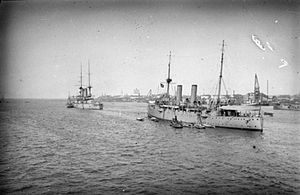| HMS Fox (1893) | |
|---|---|
 | |
| Career (UK) | |
| Name: | HMS Fox |
| Operator: | Royal Navy |
| Launched: | 15 June 1893 |
| Commissioned: | 1896 |
| Decommissioned: | March 1919 |
| Fate: | Sold for scrap 1920 |
| General characteristics | |
| Class & type: | Astraea-class protected cruiser |
| Displacement: | 4,360 tons loaded |
| Length: | 320 ft (98 m) |
| Beam: | 49 ft 6 in (15.09 m) |
| Draught: | 19 ft (5.8 m) |
| Propulsion: |
2 shaft, 3 cycle TE, 8 cylinder boilers 7500 hp natural draught; 9500 hp forced draught Coal 1000 tons maximum load |
| Speed: |
18 knots (33 km/h) natural draught 19.5 knots (36.1 km/h) forced draught |
| Range: | 7,000 nautical miles |
| Complement: | 44 |
| Armament: |
2 × QF 6 in (152 mm) |
| Armour: |
Deck 2 inch Conning tower 3 inch Gunshields 4.5 inch engine hatch 5 inch |
HMS Fox was a second class protected cruiser of the Astraea-class of the Royal Navy. The class represented an improvement on previous types, 1,000 tons displacement larger with better seaworthiness due to improved hull design. It also had somewhat increased firepower and superior arrangement of guns.
Construction[]
Ships of this category were designed for overseas duty where they were unlikely to encounter first class opposition. They were useful for showing the flag, suppressing piracy, escorting convoys during war time, supporting colonial governments, and generally intimidating minor powers. They had some use in countering armed merchant cruisers of a hostile navy.
Fox was sheathed in wood and copper, to fit her for tropical waters. The hull of an unsheathed steel vessel operating in warm waters would usually become so encrusted with barnacles that its speed would be seriously affected within six months.[1]
Operational service[]
Fox was commissioned at Portsmouth by Captain F. S. Pelham 10 September 1901 to relieve the Marathon on the East Indies Station,[2] and left home waters the following month after a commissioning trial in the Channel.[3] She arrived at Malta on 28 October,[4] and at Aden on 11 November.[5] She was paid off after six years in January 1907 and sent to the reserve fleet. In May 1908, she was recommissioned for the Home Fleet. In June 1908, she was sent once more to the East Indies where she served until 1914.
On the outbreak of the First World War Fox was 18 years old and obsolete, but continued in active service. Off Colombo, Ceylon, she captured two German merchant ships, the Australia on 10 August 1914, and the Holtenfels on 11 August 1914.
On November 3 and 4, under Captain Francis W. Caulfeild, Fox supported Indian and British troops in their unsuccessful attack on the port of Tanga in German East Africa on 3 and 4 November 1914. She then participated in the hunt for the German light cruiser SMS Königsberg and participated in a raid on Dar-es-Salaam where she bombarded the city. In January 1915 Fox was part of the force which occupied Mafia Island.
Fox served in the East Indies and Egypt from 1915 to 1917, and then in the Red Sea in 1917 to 1918. Fox played a critical role while in the Red Sea in supporting the Arab Revolt against the Ottoman Empire, flying the flag of William Boyle, 12th Earl of Cork.
In 1919 Fox was dispatched to participate as part of the British intervention in the Russian Civil War.
The ship was sold in 1920 and scrapped in Watchet Harbour in the autumn of 1923.
References[]
- ↑ Copper sheathing, Globalsecurity.org
- ↑ "Error: no
|title=specified when using {{Cite web}}". 11 September 1901. - ↑ "Error: no
|title=specified when using {{Cite web}}". 17 October 1901. - ↑ "Error: no
|title=specified when using {{Cite web}}". 29 October 1901. - ↑ "Error: no
|title=specified when using {{Cite web}}". 13 November 1901.
Sources[]
- "Old Weather - HMS Fox". http://www.oldweather.org/vessels/4caf86bbcadfd34197017699. Retrieved 2012-01-22. Transcription of ship's logbooks and weather information
The original article can be found at HMS Fox (1893) and the edit history here.